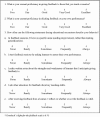Physician characteristics associated with proficiency in feedback skills
- PMID: 16704385
- PMCID: PMC1484791
- DOI: 10.1111/j.1525-1497.2006.00424.x
Physician characteristics associated with proficiency in feedback skills
Abstract
Background: Providing and eliciting high-quality feedback is valuable in medical education. Medical learners' attainment of clinical competence and professional growth can be facilitated by reliable feedback. This study's primary objective was to identify characteristics that are associated with physician teachers' proficiency with feedback.
Methods: A cohort of 363 physicians, who were either past participants of the Johns Hopkins Faculty Development Program or members of a comparison group, were surveyed by mail in July 2002. Survey questions focused on personal characteristics, professional characteristics, teaching activities, self-assessed teaching proficiencies and behaviors, and scholarly activity. The feedback scale, a composite feedback variable, was developed using factor analysis. Logistic regression models were then used to determine which faculty characteristics were independently associated with scoring highly on a dichotomized version of the feedback scale.
Results: Two hundred and ninety-nine physicians responded (82%) of whom 262 (88%) had taught medical learners in the prior 12 months. Factor analysis revealed that the 7 questions from the survey addressing feedback clustered together to form the "feedback scale" (Cronbach's alpha: 0.76). Six items, representing discrete faculty responses to survey questions, were independently associated with high feedback scores: (i) frequently attempting to detect and discuss the emotional responses of learners (odds ratio [OR]=4.6, 95% confidence interval [CI] 2.2 to 9.6), (ii) proficiency in handling conflict (OR=3.7, 95% CI 1.5 to 9.3), (iii) frequently asking learners what they desire from the teaching interaction (OR=3.5, 95% CI 1.7 to 7.2), (iv) having written down or reviewed professional goals in the prior year (OR=3.2, 95% CI 1.6 to 6.4), (v) frequently working with learners to establish mutually agreed upon goals, objectives, and ground rules (OR=2.2, 95% CI 1.1 to 4.7), and (vi) frequently letting learners figure things out themselves, even if they struggle (OR=2.1, 95% CI 1.1 to 3.9).
Conclusions: Beyond providing training in specific feedback skills, programs that want to improve feedback performance among their faculty may wish to promote the teaching behaviors and proficiencies that are associated with high feedback scores identified in this study.
Figures
Similar articles
-
Physician-teacher characteristics associated with learner-centered teaching skills.Med Teach. 2008 Jun;30(5):e137-44. doi: 10.1080/01421590801942094. Med Teach. 2008. PMID: 18576184
-
Clinician-teachers' self-assessments versus learners' perceptions.J Gen Intern Med. 2004 May;19(5 Pt 2):554-7. doi: 10.1111/j.1525-1497.2004.30014.x. J Gen Intern Med. 2004. PMID: 15109323 Free PMC article.
-
Long-term follow-up of a longitudinal faculty development program in teaching skills.J Gen Intern Med. 2005 Aug;20(8):721-5. doi: 10.1111/j.1525-1497.2005.0145.x. J Gen Intern Med. 2005. PMID: 16050881 Free PMC article.
-
Use of effective feedback to facilitate adult learning.J Cancer Educ. 1996 Summer;11(2):106-18. doi: 10.1080/08858199609528405. J Cancer Educ. 1996. PMID: 8793652 Review.
-
[Providing successful education and further training: 10 tips].Ned Tijdschr Geneeskd. 2014;158:A8137. Ned Tijdschr Geneeskd. 2014. PMID: 25308228 Review. Dutch.
Cited by
-
Giving feedback on clinical skills: are we starving our young?J Grad Med Educ. 2012 Jun;4(2):154-8. doi: 10.4300/JGME-D-11-000295.1. J Grad Med Educ. 2012. PMID: 23730434 Free PMC article.
-
Preceptor development: providing effective feedback, part 2.Hosp Pharm. 2014 Jun;49(6):521-9. doi: 10.1310/hpj4906-521. Hosp Pharm. 2014. PMID: 24958969 Free PMC article.
-
The case Conference Assessment Tool (cCAT): a new workplace-based assessment.Clin Med (Lond). 2014 Aug;14(4):386-90. doi: 10.7861/clinmedicine.14-4-386. Clin Med (Lond). 2014. PMID: 25099840 Free PMC article.
-
Examining the nature of feedback within the Mini Clinical Evaluation Exercise (Mini-CEX): an analysis of 1427 Mini-CEX assessment forms.GMS J Med Educ. 2018 Nov 15;35(4):Doc47. doi: 10.3205/zma001193. eCollection 2018. GMS J Med Educ. 2018. PMID: 30539072 Free PMC article.
-
Teaching feedback to first-year medical students: long-term skill retention and accuracy of student self-assessment.J Gen Intern Med. 2009 Jun;24(6):721-6. doi: 10.1007/s11606-009-0983-z. Epub 2009 Apr 22. J Gen Intern Med. 2009. PMID: 19384559 Free PMC article.
References
-
- Encyclopaedia Britannica Online. [February 22, 2004]. Available at http://www.britannica.com.
-
- Ende J. Feedback in clinical medical education. JAMA. 1983;250:777–81. - PubMed
-
- Gorn MH. Lexington: University Press of Kentucky; 2001. Expanding the Envelope: Flight Research at NACA and NASA.
-
- Nadler DA. Reading, MA: Addison-Wesley Publishing Company Inc; 1977. Feedback and Organization Development: Using Data-Based Methods.
-
- Ericsson KA. Deliberate practice and the acquisition and maintenance of expert performance in medicine and related domains. Acad Med. 2004;79(suppl 10):S70–S81. - PubMed
Publication types
MeSH terms
Grants and funding
LinkOut - more resources
Full Text Sources
Miscellaneous

